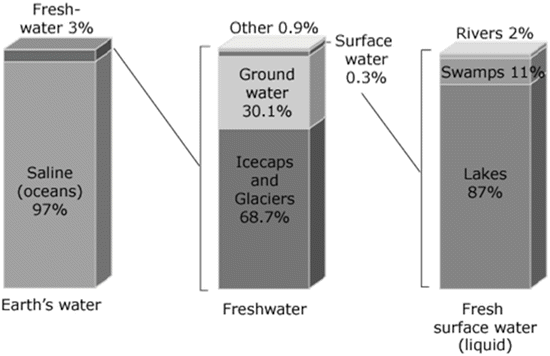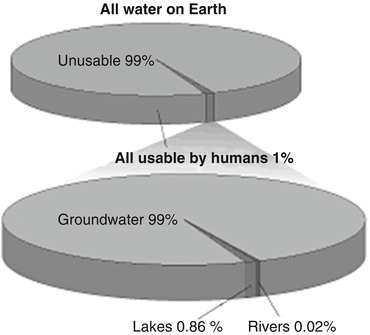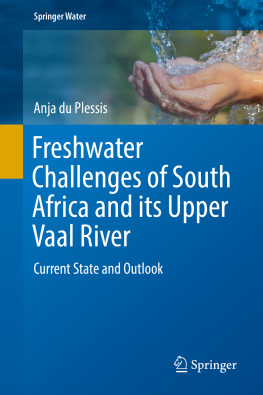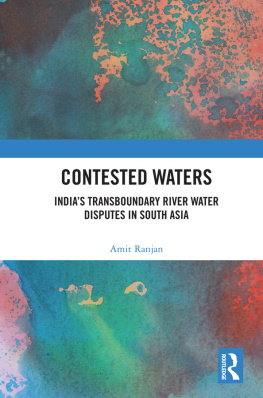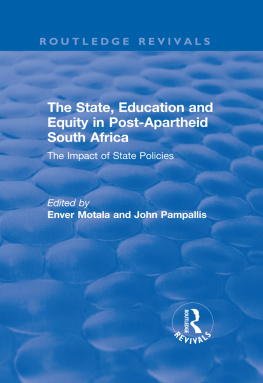Water is one of the most widely distributed substances across the worlds surface and is crucial for a variety of aspects of human health, development and well-being as well as for the functioning of natural ecosystems. It has been recognised as a fundamental human right internationally and consequently needs to be managed both effectively and efficiently to ensure that global water needs are met. The distribution of water across the globe is uneven and the availability thereof becoming an increasingly major concern. The main water use sectors, grouped in terms of agriculture, industrial (includes industrial activities, mining and energy) as well as municipal/domestic, recreational and environmental water use, have an influence on water availability through physical water abstraction as well as through water degradation. Global challenges in terms of water availability and water use are highlighted. Focus is placed on the availability, distribution and use of freshwater resources on a global scale.
1.1 Introduction
Water is one of the most widely distributed substances to be found in the natural environment and constitutes the earths oceans, seas, lakes, rivers and underground water sources. This substance is crucial for various aspects of human health, development and well-being. The United Nations has recognised the importance of this resource by incorporating it into the Millennium Development Goals (MDGs) and by proclaiming the years 20052015 as the International Decade for Action Water for Life (UN Water ). The importance of water has continued to be recognised with the incorporation thereof into the new Sustainable Development Goals (SDGs) which are Global Goals primarily set to transform the world and part of the 2030 Agenda for sustainable development. Water has thus been continually recognised as a fundamental human right internationally and it is vital that it be managed effectively and efficiently on a global and national scale. This Chapter will focus upon the availability, distribution and use of freshwater resources on a global scale.
1.2 Water Availability and Distribution
Approximately 75% of the Earths surface is covered by water. However, this is just an estimate as the dynamic nature and permanent motion of water makes it difficult to reliably assess the total water stock/store of the earth. Current estimates are that the earths hydrosphere contains approximately 1386 million km3 of water. However, not all of these resources are potentially available to humans since freshwater is required by the agricultural sector, industries, and domestic and recreational users (Kibona et al. ).
Figure ).
Fig. 1.1
Distribution of the Earths water (Lui et al. )
As indicated in Fig. ).
Fig. 1.2
Water available on Earth for human consumption (Lui et al. )
Numerous desalinisation plants, in fact more than 14,000, have been developed over the globe as a result of limited freshwater supplies. These plants produce over 60.5 billion litres of water daily and most of the Persian Gulf countries rely on such plants. Thus, without the implementation of these desalinisation plants or reverse osmosis technologies, the worlds potable water supply would be very limited (Kibona et al. ).
The most fundamental function of water is firstly as a prerequisite for life on Earth and secondly, as a commodity or economic resource. These two roles are constantly in conflict with each other in many areas of water usage. This has led to the exploitation of water through human activities which has in turn placed huge risks on aquatic ecosystems and the life that they support (Pimentel et al. ).
The distribution of water across the worlds surface also plays a role. It is important to note that both the human population and water resources are unevenly distributed across the Earths surface. Areas that are densely populated by human populations do not necessarily coincide with regions that are rich in water supplies. The minimum basic water requirement for human health is 50 L per capita per day and the minimum amount of water required per capita for food is approximately 400,000 L per year, as estimated by the World Business Council for Sustainable Development. However, regions such as the United States of America (USA) consume more than eight times that amount for human consumption and four times that amount per year for food production. This confirms the fact that water resources are unevenly distributed across the world (Kibona et al. ).
The changes that are currently being experienced in the further development of regions across the world have resulted in a pandemic array of changes in the terrestrial component of the water cycle. These changes relate in part to universal transformations in the global water system and are not isolated. Amongst others, they include the universal changes in freshwater systems in terms of the following.
Physical characteristics: These include long-term changes in surface and subsurface moisture storage and runoff, and persistent changes in precipitation and hydrological patterns. It is said that researchers generally have a limited understanding of the global scale manifestation of local hydrological mechanisms, as well as the intensity of such changes in the different regions. The altercation of physical characteristics of freshwater systems through developments such as mining operations can change characteristics such as the systems soils, wetland hydrology and geomorphology within one region and have unintended altering effects or cumulative impacts such as increased sedimentation or the altercation of a different freshwater system in another connected region or area (Alcamo et al. ).
Chemistry and biology: These include long-term alterations in the flow of nutrients and sediments toward the oceans, as well as the key levels of water quality and habitat parameters. The over utilization of freshwater systems through various human activities can be accompanied with an influx of nutrients within aquatic habitats and consequently greatly reduce aquatic organisms and hold severe consequences for aquatic ecosystems. An example of this could include the continued increase of waste water in the degradation of water quality on aquatic ecosystems and freshwater fisheries which remain an important protein for the poor population (Alcamo et al. ).
Anthropogenic water use and withdrawal: These include rapidly changing patterns of water consumption across different economic sectors and regions. Industrialised countries now tend to be associated with reduced withdrawals of water while the volumes of water withdrawn in the developing regions are increasing. These trends have caused changes in water stress patterns with uncertain global implications (Alcamo et al. ).
